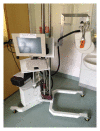A systematic review of the evolution of laser Doppler techniques in burn depth assessment
- PMID: 25180087
- PMCID: PMC4142313
- DOI: 10.1155/2014/621792
A systematic review of the evolution of laser Doppler techniques in burn depth assessment
Abstract
Aims. The introduction of laser Doppler (LD) techniques to assess burn depth has revolutionized the treatment of burns of indeterminate depth. This paper will systematically review studies related to these two techniques and trace their evolution. At the same time we hope to highlight current controversies and areas where further research is necessary with regard to LD imaging (LDI) techniques. Methods. A systematic search for relevant literature was carried out on PubMed, Medline, EMBASE, and Google Scholar. Key search terms included the following: "Laser Doppler imaging," "laser Doppler flow," and "burn depth." Results. A total of 53 studies were identified. Twenty-six studies which met the inclusion/exclusion criteria were included in the review. Conclusions. The numerous advantages of LDI over those of LD flowmetry have resulted in the former technique superseding the latter one. Despite the presence of alternative burn depth assessment techniques, LDI remains the most favoured. Various newer LDI machines with increasingly sophisticated methods of assessing burn depth have been introduced throughout the years. However, factors such as cost effectiveness, scanning of topographically inconsistent areas of the body, and skewing of results due to tattoos, peripheral vascular disease, and anaemia continue to be sighted as obstacles to LDI which require further research.
Figures


References
-
- Cubison TCS, Pape SA, Parkhouse N. Evidence for the link between healing time and the development of hypertrophic scars (HTS) in paediatric burns due to scald injury. Burns. 2006;32(8):992–999. - PubMed
-
- Monstrey S, Hoeksema H, Verbelen J, Pirayesh A, Blondeel P. Assessment of burn depth and burn wound healing potential. Burns. 2008;34(6):761–769. - PubMed
-
- Stern MD. In vivo evaluation of microcirculation by coherent light scattering. Nature. 1975;254(5495):56–58. - PubMed
-
- Green M, Holloway GA, Heimbach DM. Laser Doppler monitoring of microcirculatory changes in acute burn wounds. Journal of Burn Care & Rehabilitation. 1988;9(1):57–62. - PubMed
-
- O'Reilly T, Spence R, Taylor R, Scheulen J. Laser Doppler flowmetry evaluation of burn wound depth. Journal of Burn Care & Rehabilitation. 1989;10(1):1–6. - PubMed
Publication types
LinkOut - more resources
Full Text Sources
Other Literature Sources
Medical
Research Materials
Miscellaneous

